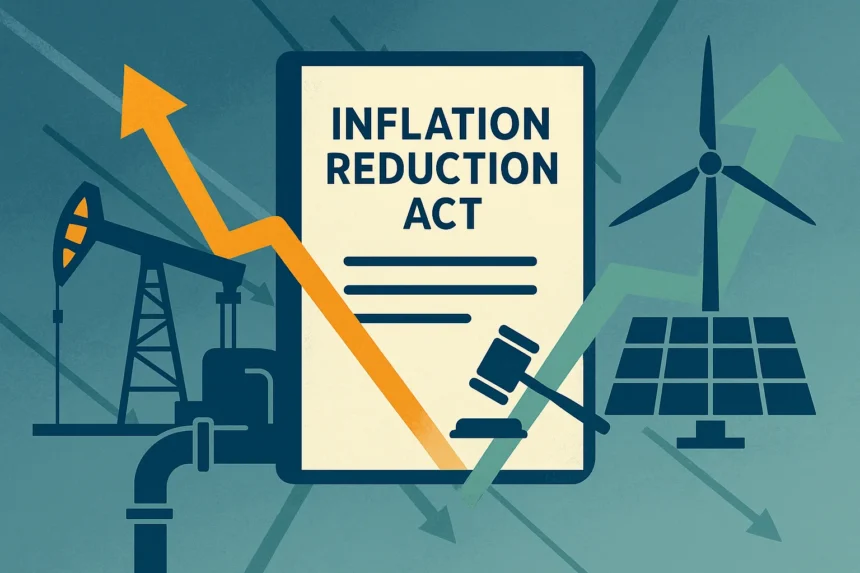The Inflation Reduction Act (IRA) of 2022 marked a significant shift in U.S. climate, energy, and tax policy. Naturally, such a sweeping piece of legislation generated considerable debate, particularly from industry groups. One specific query that has gained traction is about an “API Inflation Reduction Act 10 year pause.” If you’ve encountered this phrase and are looking for a clear explanation, you’re not alone. This isn’t a provision within the Inflation Reduction Act full text itself, but rather reflects a key point of contention and proposals from the American Petroleum Institute (API) regarding the act’s long-term implications.
As a market commentator, my goal is to translate these complex policy shifts into clear insights. Let’s unpack what the “API Inflation Reduction Act 10 year pause” refers to and what it means for the energy sector and the broader economy.
The “10-Year Pause” Misconception: Clarifying API’s Stance on the IRA
The phrase “API Inflation Reduction Act 10 year pause summary” or similar searches often stem from the American Petroleum Institute’s (API) advocacy efforts. It’s crucial to understand that the IRA, signed into law in 2022, does not contain a specific “10-year pause” on oil and gas activities. Instead, the API, representing a vast segment of the U.S. oil and natural gas industry, has consistently argued against certain provisions of the IRA and advocated for policies that support increased domestic energy production.
API’s concern is that the IRA, while promoting clean energy, imposes new taxes and fees on the oil and gas industry that could stifle investment and production. Their proposals, often encapsulated in broader policy roadmaps, have sometimes included calls for more stable, long-term regulatory frameworks that avoid abrupt policy shifts, effectively a “pause” on what they perceive as detrimental regulatory changes. This has led to the common search terms like “API Inflation Reduction Act 10 year pause 2022,” reflecting the period after the IRA’s enactment.
Key API Concerns and the Inflation Reduction Act’s Energy Provisions
To understand the API’s perspective, we need to look at specific aspects of the IRA that directly impact the fossil fuel sector:
- Methane Emissions Charge: The IRA imposes a charge on methane emissions from oil and gas facilities, starting at $900 per ton in 2024 and rising to $1,500 per ton by 2026. API argues this is an additional tax that could burden producers.
- Corporate Minimum Tax: The act introduced a 15% corporate minimum tax on large corporations, affecting many energy companies.
- Increased Royalty Rates: The IRA raised royalty rates for oil and gas leases on federal lands and waters, increasing the cost of extraction.
- Reduced Drilling Acreage: While the IRA mandated new oil and gas lease sales, it also tied them to renewable energy leasing, and API often expresses concern over overall reductions in available acreage for drilling.
API’s argument centers on the idea that these measures, while intended to fund clean energy and reduce emissions, could disincentivize domestic production. They advocate for a predictable regulatory environment to ensure energy security and affordability. Their “API 5 Point Policy Roadmap” (a term often searched by those looking for their official stance) typically includes calls for supporting U.S. energy production, streamlining permitting, and avoiding new taxes on energy.
Economic Implications and the Future of U.S. Energy Policy
The debate around the “API Inflation Reduction Act 10 year pause” highlights the ongoing tension between energy security, economic growth, and climate goals. For business leaders, the implications are significant:
- Investment Decisions: Energy companies face increased uncertainty. Will the incentives for renewables outweigh the new costs for fossil fuels? This influences where capital is allocated.
- Energy Prices: API suggests that disincentivizing domestic production could lead to higher energy costs for consumers and businesses, especially as global demand remains high.
- Innovation vs. Regulation: The IRA aims to spur innovation in clean energy through substantial tax credits. However, API argues that overly burdensome regulations could impede all energy innovation.
The concept of a “10-year pause” from API is less about a literal halt and more about a desire for policy stability that allows for long-term planning and investment in traditional energy sources, alongside the growth of renewables.
Conclusion: Navigating the Nuances of the API Inflation Reduction Act Debate
Understanding phrases like “API Inflation Reduction Act 10 year pause” requires digging beyond the headlines to the core policy debates. While there isn’t a literal “pause” written into the Inflation Reduction Act 2022 full text, the keyword points to the critical discussions surrounding the IRA’s impact on the U.S. energy sector.
For business leaders and investors, the key takeaway is the ongoing dynamic between government policy, industry advocacy, and market realities. The future of U.S. energy policy will continue to be shaped by these competing forces, demanding careful analysis to navigate both risks and opportunities. Staying informed on these policy shifts and their economic ramifications remains paramount for strategic decision-making in the years ahead.




